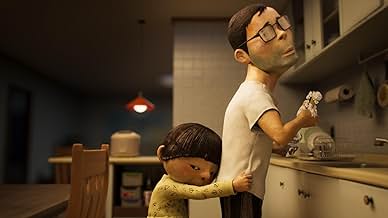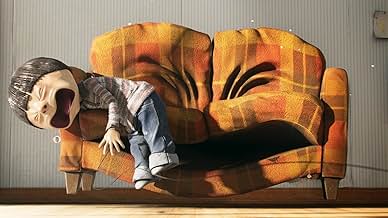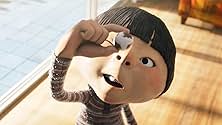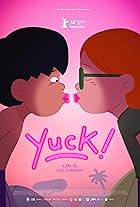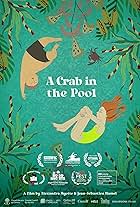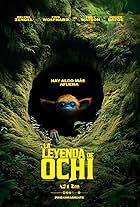Agrega una trama en tu idiomaThe other kids never ask Dong-Dong to play, but he's fine just playing marbles on his own. Until one day, he buys a bag of colorful candies and begins to discover new voices and perspectives... Leer todoThe other kids never ask Dong-Dong to play, but he's fine just playing marbles on his own. Until one day, he buys a bag of colorful candies and begins to discover new voices and perspectives.The other kids never ask Dong-Dong to play, but he's fine just playing marbles on his own. Until one day, he buys a bag of colorful candies and begins to discover new voices and perspectives.
- Dirección
- Guionistas
- Elenco
- Nominado a 1 premio Óscar
- 3 nominaciones en total
Hiroshi Iwasaki
- Sofa
- (voz)
- (as Hiroshi Iwaski)
Sakiko Uran
- Grandma
- (voz)
Ikkei Watanabe
- Dad
- (voz)
Kiko Ôi
- Young Dong-Dong
- (voz)
- (as Oi Kiko)
- Dirección
- Guionistas
- Todo el elenco y el equipo
- Producción, taquilla y más en IMDbPro
Opiniones destacadas
A young boy prefers to play marbles with his dog rather than join in the other children's games. He buys some new marbles. They turn out to be candies, which let him hold conversations with his couch, his dog, and so forth. Along the way he finds he has to leave some things behind.
There's no subtlety in this Japanese short about coming to terms with yourself and learning to deal with other people. It's magnificently designed -- you can see the pilling on the boy's shirt. I'd rate it good, but in a year where I wasn't terribly impressed by the competition, this looks like it might win the Oscar for Best Animated Short.
There's no subtlety in this Japanese short about coming to terms with yourself and learning to deal with other people. It's magnificently designed -- you can see the pilling on the boy's shirt. I'd rate it good, but in a year where I wasn't terribly impressed by the competition, this looks like it might win the Oscar for Best Animated Short.
With its dreamy animation, magical realism, and themes of loneliness and finding one self. This 21-minute short film is a pure heartwarming journey through the eyes of a lonely boy named Dong-Dong who with his magic candies sets to communicate with his past and discover himself.
I personally loved the bond between Dong-Dong and his dog, Gunsuri, truly a standout sequence in this short film. From playful puppy days to their quieter moments now, it's a heartfelt reminder of how pets become family. And when Dong-Dong finally connects with his grandma near the end, it's pure warmth, you can feel the love in every frame. Also the early conversation with the couch was funny. The moments with his dad when he will be doing the dishes was neatly done.
Sure, the ending is predictable, but it doesn't matter. What sticks with you is the soothing tone and simple message: sometimes, breaking free from your own head means opening up to those around you. The background score complemented the ending scene.
It reminded me of some of my favorites films that find magic in everyday life. Shinji Somai's Moving (1993), Aivars Freimanis's Puika (1967), Hugo and Josefin (1967), and Royston Stan's 4:30 (2005). I have reviewed all these titles so of you have a time please check it out.
In closing, this is a good short film cozy, and full of heart, this one's worth a watch. No wonder it's up for a 2025 Oscar's.
I personally loved the bond between Dong-Dong and his dog, Gunsuri, truly a standout sequence in this short film. From playful puppy days to their quieter moments now, it's a heartfelt reminder of how pets become family. And when Dong-Dong finally connects with his grandma near the end, it's pure warmth, you can feel the love in every frame. Also the early conversation with the couch was funny. The moments with his dad when he will be doing the dishes was neatly done.
Sure, the ending is predictable, but it doesn't matter. What sticks with you is the soothing tone and simple message: sometimes, breaking free from your own head means opening up to those around you. The background score complemented the ending scene.
It reminded me of some of my favorites films that find magic in everyday life. Shinji Somai's Moving (1993), Aivars Freimanis's Puika (1967), Hugo and Josefin (1967), and Royston Stan's 4:30 (2005). I have reviewed all these titles so of you have a time please check it out.
In closing, this is a good short film cozy, and full of heart, this one's worth a watch. No wonder it's up for a 2025 Oscar's.
"Magic Candies" is one of those short films that beautifully blends magic, emotion, and reflection. The film takes us on the journey of a lonely boy who, after eating magical candies, gains the ability to communicate with inanimate objects, animals, and even people around him. This peculiar gift opens doors for new discoveries, not only about the world but also about himself, and it's through this self-discovery journey that the film really shines.
Right from the start, the story delves into the theme of loneliness, something we've all felt at some point in life. The protagonist is a boy who's okay with his own company, but there's also a quiet desire for connection. This dilemma is portrayed in a delicate and honest way, showing how, often, loneliness can be a refuge, but the longing to connect with others is inevitable. The film is a touching and realistic depiction of how we feel when we can't find our place in the world, and how that feeling often leads us to discover new ways to express ourselves.
The animation in "Magic Candies" is a spectacle in itself. The film's aesthetic combines different textures and styles, which not only reflects the richness of the world around the protagonist but also visually captures the character's internal transformation. The mix of colors and shapes, from playful to poetic, helps create a unique atmosphere where magic isn't just in what the boy sees, but also in what he feels. The transitions between scenes-where objects come to life and even animals convey messages-are fluid and engaging, making the audience lose themselves along with the boy in his new world of possibilities.
The strongest point of the film is definitely how it handles communication. Throughout his journey, the protagonist connects with others in unexpected ways, whether it's a talking couch, a dog with its own thoughts, or even people who once seemed distant. This new understanding of others is actually a reflection of the character's own self-discovery process. For the first time, he begins to realize that his own voice has power, and this transformation is treated sensitively and almost poetically. The sweet, transparent candy at the end-shiny and symbolizing the final stage of his evolution-is a simple yet incredibly effective metaphor for the importance of finding our own voice.
The film's narrative is deep but never overly complex. Themes of loneliness, connection, and self-awareness are tackled with a delicacy that touches the heart without veering into sentimentality. The way the boy transitions from a silent, closed world to one where he can finally hear and be heard is a reflection of something universal: we all seek to be understood, and true connection only happens when we can express ourselves without fear or barriers. The film conveys this message in a natural, unhurried way, allowing the protagonist's journey to feel genuine.
The soundtrack and voiceovers also deserve special mention. The soft, emotional music complements the scenes almost invisibly but is essential to create the right atmosphere. The voices, on the other hand, are eloquent and help bring the characters to life, making the simple act of "talking" to objects and animals feel much more meaningful. The casting choices for the voices were spot on, adding an extra layer of depth to the narrative.
In terms of character development, the protagonist is absolutely captivating. The way his facial expressions and body language change as he gains confidence and understanding is masterful. The boy starts the film closed off and introverted, but with every magical candy he consumes, he becomes more open and willing to explore the world around him. This evolution is natural and believable, and it's impossible not to relate to his journey, whether on a personal or emotional level.
In the end, "Magic Candies" is a work that doesn't just tell a fantasy story but also invites us to reflect on what it really means to connect with others and, more importantly, with ourselves. The adaptation of this literary piece, now brought to animation, captures the essence of growing up, understanding the world, and finally finding your own voice.
Right from the start, the story delves into the theme of loneliness, something we've all felt at some point in life. The protagonist is a boy who's okay with his own company, but there's also a quiet desire for connection. This dilemma is portrayed in a delicate and honest way, showing how, often, loneliness can be a refuge, but the longing to connect with others is inevitable. The film is a touching and realistic depiction of how we feel when we can't find our place in the world, and how that feeling often leads us to discover new ways to express ourselves.
The animation in "Magic Candies" is a spectacle in itself. The film's aesthetic combines different textures and styles, which not only reflects the richness of the world around the protagonist but also visually captures the character's internal transformation. The mix of colors and shapes, from playful to poetic, helps create a unique atmosphere where magic isn't just in what the boy sees, but also in what he feels. The transitions between scenes-where objects come to life and even animals convey messages-are fluid and engaging, making the audience lose themselves along with the boy in his new world of possibilities.
The strongest point of the film is definitely how it handles communication. Throughout his journey, the protagonist connects with others in unexpected ways, whether it's a talking couch, a dog with its own thoughts, or even people who once seemed distant. This new understanding of others is actually a reflection of the character's own self-discovery process. For the first time, he begins to realize that his own voice has power, and this transformation is treated sensitively and almost poetically. The sweet, transparent candy at the end-shiny and symbolizing the final stage of his evolution-is a simple yet incredibly effective metaphor for the importance of finding our own voice.
The film's narrative is deep but never overly complex. Themes of loneliness, connection, and self-awareness are tackled with a delicacy that touches the heart without veering into sentimentality. The way the boy transitions from a silent, closed world to one where he can finally hear and be heard is a reflection of something universal: we all seek to be understood, and true connection only happens when we can express ourselves without fear or barriers. The film conveys this message in a natural, unhurried way, allowing the protagonist's journey to feel genuine.
The soundtrack and voiceovers also deserve special mention. The soft, emotional music complements the scenes almost invisibly but is essential to create the right atmosphere. The voices, on the other hand, are eloquent and help bring the characters to life, making the simple act of "talking" to objects and animals feel much more meaningful. The casting choices for the voices were spot on, adding an extra layer of depth to the narrative.
In terms of character development, the protagonist is absolutely captivating. The way his facial expressions and body language change as he gains confidence and understanding is masterful. The boy starts the film closed off and introverted, but with every magical candy he consumes, he becomes more open and willing to explore the world around him. This evolution is natural and believable, and it's impossible not to relate to his journey, whether on a personal or emotional level.
In the end, "Magic Candies" is a work that doesn't just tell a fantasy story but also invites us to reflect on what it really means to connect with others and, more importantly, with ourselves. The adaptation of this literary piece, now brought to animation, captures the essence of growing up, understanding the world, and finally finding your own voice.
¿Sabías que…?
- Citas
Stationary Store Owner: Those aren't marbles. Those are candies. They're very sweet.
- ConexionesFeatured in The Oscars (2025)
Selecciones populares
Inicia sesión para calificar y agrega a la lista de videos para obtener recomendaciones personalizadas
Detalles
- Tiempo de ejecución20 minutos
- Color
- Relación de aspecto
- 16:9 HD
Contribuir a esta página
Sugiere una edición o agrega el contenido que falta

Principales brechas de datos
By what name was Magic Candies (2024) officially released in Canada in English?
Responda
